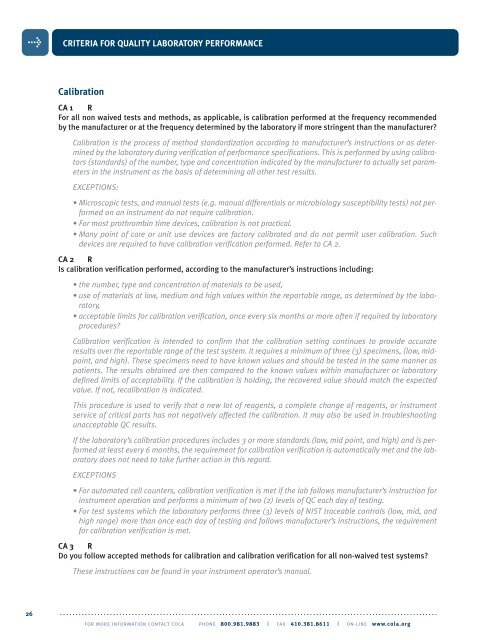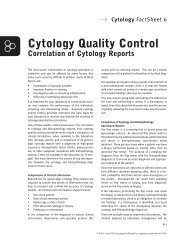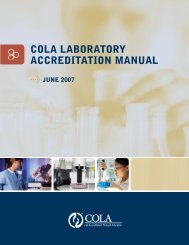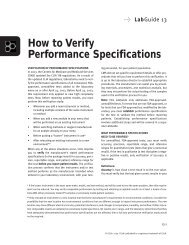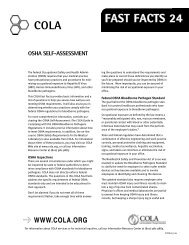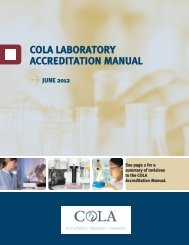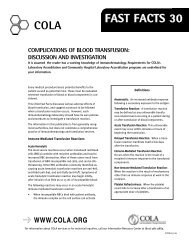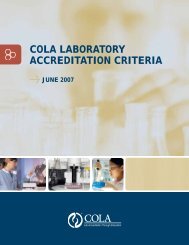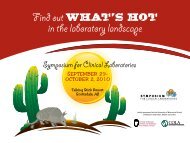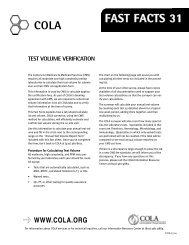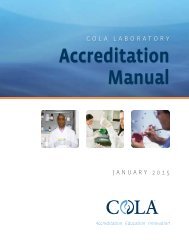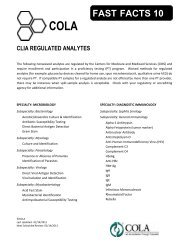#06-5558 Accrd Manual V7 - COLA
#06-5558 Accrd Manual V7 - COLA
#06-5558 Accrd Manual V7 - COLA
- No tags were found...
Create successful ePaper yourself
Turn your PDF publications into a flip-book with our unique Google optimized e-Paper software.
CRITERIA FOR QUALITY LABORATORY PERFORMANCECalibrationCA 1 RFor all non waived tests and methods, as applicable, is calibration performed at the frequency recommendedby the manufacturer or at the frequency determined by the laboratory if more stringent than the manufacturer?Calibration is the process of method standardization according to manufacturer’s instructions or as determinedby the laboratory during verification of performance specifications. This is performed by using calibrators(standards) of the number, type and concentration indicated by the manufacturer to actually set parametersin the instrument as the basis of determining all other test results.EXCEPTIONS:• Microscopic tests, and manual tests (e.g. manual differentials or microbiology susceptibility tests) not performedon an instrument do not require calibration.• For most prothrombin time devices, calibration is not practical.• Many point of care or unit use devices are factory calibrated and do not permit user calibration. Suchdevices are required to have calibration verification performed. Refer to CA 2.CA 2 RIs calibration verification performed, according to the manufacturer’s instructions including:• the number, type and concentration of materials to be used,• use of materials at low, medium and high values within the reportable range, as determined by the laboratory,• acceptable limits for calibration verification, once every six months or more often if required by laboratoryprocedures?Calibration verification is intended to confirm that the calibration setting continues to provide accurateresults over the reportable range of the test system. It requires a minimum of three (3) specimens, (low, midpoint,and high). These specimens need to have known values and should be tested in the same manner aspatients. The results obtained are then compared to the known values within manufacturer or laboratorydefined limits of acceptability. If the calibration is holding, the recovered value should match the expectedvalue. If not, recalibration is indicated.This procedure is used to verify that a new lot of reagents, a complete change of reagents, or instrumentservice of critical parts has not negatively affected the calibration. It may also be used in troubleshootingunacceptable QC results.If the laboratory’s calibration procedures includes 3 or more standards (low, mid point, and high) and is performedat least every 6 months, the requirement for calibration verification is automatically met and the laboratorydoes not need to take further action in this regard.EXCEPTIONS• For automated cell counters, calibration verification is met if the lab follows manufacturer’s instruction forinstrument operation and performs a minimum of two (2) levels of QC each day of testing.• For test systems which the laboratory performs three (3) levels of NIST traceable controls (low, mid, andhigh range) more than once each day of testing and follows manufacturer’s instructions, the requirementfor calibration verification is met.CA 3 RDo you follow accepted methods for calibration and calibration verification for all non-waived test systems?These instructions can be found in your instrument operator’s manual.26. . . . . . . . . . . . . . . . . . . . . . . . . . . . . . . . . . . . . . . . . . . . . . . . . . . . . . . . . . . . . . . . . . . . . . . . . . . . . . . . . . . . . . . . . . . . . . . . . . . . . . . . . . . . . . . . . . . . . . . . .FOR MORE INFORMATION CONTACT <strong>COLA</strong> PHONE 800.981.9883 | FAX 410.381.8611 | ON-LINE www.cola.org


